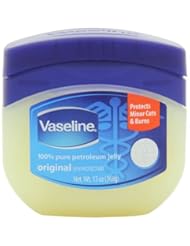One of my girlfriends recommended a lotion to me recently, but as soon as I read the ingredients, I knew I would never use it because the first thing listed was mineral oil.
What’s so bad about mineral oil, the friend asked?

Well, for starters, mineral oil and Vasoline Petroleum Jelly are byproducts from refining oil. Yep, they are pulled out of the sludge found at the bottom of the barrels at oil refineries. They are literally “toxic waste.”
My friend persisted: Why shouldn’t you put petroleum products on your skin? She believed her skin felt softer after using petroleum products, particularly on rough patches of eczema.
Let’s start with the fact that our skin is our largest organ. Skin cells breathe and metabolize just as all of our body cells do, and they absorb chemicals through contact. Adding chemicals to your skin will increase your overall toxic load in your body which could hasten the onset of a health crisis.
Slathering mineral oil or petroleum jelly on skin smothers skin cells and prevents efficient cellular respiration. While you might feel an immediate softening effect, or even feel as if the product is moisturizing, you are in fact simply putting a layer of inorganic oil over your cells and trapping moisture underneath the skin while not allowing any more moisture to enter.
Our bodies were designed to efficiently rid the system of toxins through discharges from the bowels and urinary tract, mucous from the nose or throat, and perspiration and cellular respiration through the skin. Sealing off the skin thwarts this process and traps toxins inside the body.

Petroleum is found deep underground, often a mile or more below the surface where life exists. For the course of human history, petroleum has been inaccessible and unused until very recently. Mammals did not evolve to need or use petroleum or its byproducts as part of achieving health. Just because Vasoline is a familiar brand doesn’t mean it is safe to use. Marlboro is a familiar brand, too, but that doesn’t mean its products are any safer for having been around for a century.
I cringe every time I hear of another pediatrician recommending feeding a child spoonfuls of mineral oil as a misguided constipation remedy. Mineral oil does not rinse off cleanly; it leave a residual layer of petroleum, which is what makes things slippery. I can’t imagine smothering the cells of the digestive tract with a clinging film in any way helps to improve digestion. It might ease constipation by greasing the chute, but it inhibits nutrient absorption through the intestines in the process. A destructive trade-off, if you ask me.
A recent Huffington Post article by Rebecca Adams brought a comment from a reader addicted to using Vasoline on her lips. She felt disgusted at the thought of how much petroleum she must have directly ingested over the years, but couldn’t think of a safer replacement for her dry lips. I’m a fan of Zum Kiss Shea Butter Lip Balm for safely moisturized lips.
Try almond oil for moisturizing skin for a safe, natural skin softener that heals while it softens and does not inhibit cellular respiration.


